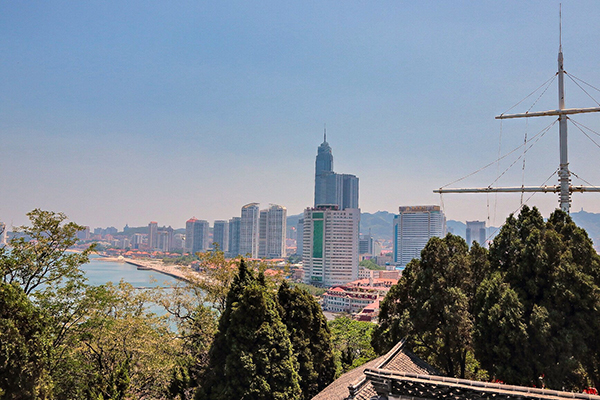Yantai: A wide angle
Updated : 2019-03-18
(chinadaily.com.cn)
 |
|
Coastal Yantai from Yantaishan 2017[Photo by Bruce Connolly/chinadaily.com.cn] |
There are places in China I want to return again and again. Just for the personal joy of immersing myself, of once more being there. I first visited Yantai, on the northern coast of Shandong province, in 2017, surprisingly late during my journeys of discovery throughout China. I wondered why visiting it not earlier turned out to be much better than expected. Maybe it was simply waking up on my first morning at the delightful Golden Gulf Hotel, nestled at the base of Yantaishan Hill. The sun was rising over a totally calm, indeed tranquil, Bohai Gulf. As I watched, absolutely transfixed, hilly Kongtong Island emerged as dawn mist dispersed across the bay. Below my window people were already exercising or walking along the broad seafront promenade. The previous evening, after arriving by train from Beijing, I had sat there by the sea listening to the waves lapping gently on the shore. Soon I started to feel a sense of relaxation Yantai seems to induce in people.
That first morning, after breakfast, I walked up traffic-free lanes on Yantaishan under a warm, cloudless sky. Passing often elegant former international consulate buildings it felt such a contrast to my normal living in a bustling part of Beijing. Abundant flower beds scented the air alongside lush blends of coniferous and deciduous trees combined with the cool gentle sea breeze.
Over a week I explored, a bit like a tourist, historic buildings; the fishing harbor; rocky and sandy coastlines and of course sampled its fine wines! The city, I later learned, had been occupied by Anglo-French force in 1860, opening to international commerce as a treaty port in 1861. This accounted for the areas of European-influenced architecture I came upon while wandering around the neighborhoods of pedestrian-only Chaoyang Street within older Zhifu District. This included fascinating residential and commercial areas, once associated with fishing and maritime commerce, that had grown up around Yantai’s early port just southwest of Yantaishan. Within time I was sure redevelopment would lead to some disappearance or maybe gentrification for fewer people continued to live there leading to building disrepair and sadly even abandonment. Photography allows a recording of such testimonies in stone to preserve the memories allowing later comparisons as I have been able to do in other parts of China.
There was a realization that Yantai had more to offer than I had experienced in one visit. It was fascinating to return during different seasons from pleasant spring, through hot humid summer and into autumn with its encroaching storms. The latter proved quite spectacular as I walked from the hotel, watching waves crash up and onto the promenade. By next morning, calm had returned. That afternoon I climbed up to a vantage point overlooking the older harbor area and fishing town dominated by the historic lighthouse on Yantaishan. The hill and adjoining land formed natural protection for the early docks. Today most commerce revolves around the many large vessels berthing at newer facilities farther west, some located almost below where I stood.

